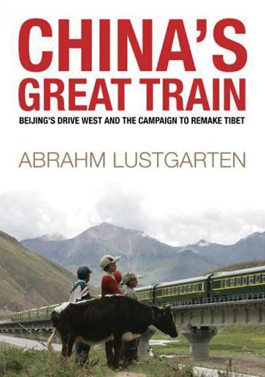home | metro silicon valley index | the arts | books | review

China's Great Train
Beijing's Drive West and the Remaking of Tibet
By Michael S. Gant
In 2006, high-speed trains began running on the Qinghai-Tibet Railway, an astonishing 700-plus-mile, high-altitude route to Lhasa across the Tibetan Plateau, "home to the largest subarctic permafrost region on the planet, a delicate frozen soil that becomes treacherous when it melts," as Abrahm Lustgarten writes in his new book on the planning (which took more than 50 years) and building—as well as the ramifications—of this astounding project. Lustgarten tells the tale of the tracks through the work of Zhang Luxin, who devoted himself to understanding the geology of permafrost, which presented an unstable surface for laying rail; and Zhao Shiyun, a structural engineer who oversaw the complex construction effort. Beyond the technical marvels—a device called a thermosyphon, or "cooling stick," used to wick warmth away from the ground to keep it from melting and sinking; train cars equipped with individual oxygen tubes to help passengers survive at punishing altitudes—Lustgarten also considers the social and political context of the QTR. China's heavily subsidized economic push in Tibet is supposed to benefit the locals by bringing them high wages, better living conditions and consumer goods. Lustgarten, an intrepid traveler, learned on several treks through Tibet that reality runs far behind intention. The economic development largely benefits Han Chinese who resettle in Tibet. The Chinese government has its sights on extracting the mineral wealth of the autonomous region, and once-remote Lhasa has become a sprawling boomtown: "To leave a neighborhood for 24 hours meant returning to find it had changed shape, another building gone, new scaffolding erected in its place." Even the iconic Potala Palace, the home of the Dalai Lama (when he's not in exile), is overshadowed by new high-rises. Nomads have been shifted off their lands, given minimal relocation fees and stuck in concrete-bunker homes where they can no longer sustain their traditional way of life. It becomes apparent, even as Lustgarten tries to be evenhanded, that China sees Tibet as a frontier outlet for his burgeoning economy, and that the Tibetans have about as much place in the scheme of things as the Indians did when America embarked on its westward migration. The Chinese even call their version of Manifest Destiny the Go West initiative, and the resettlement of the nomads sounds a lot like the herding of Native Americans onto reservations. To add insult to injury, the new touristic possibilities of Tibet demand some local color, even if Nepalese have to be brought in because they look more authentically "ethnic." The scariest quote of all comes from Lhasa's mayor, Norbu Toinzhub: "Tourists admire the Tibetan culture because it is unique. The Tibetan culture will not disappear when there is a market demand for it." (By Abraham Lustgarten; Times Books/Henry Holt and Co.; 305 pages; $26 cloth)
Send a letter to the editor about this story.
|
|
|
|
|
|